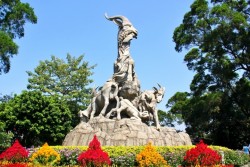

Introducing Museum of the Mausoleum of the Nanyue King
Guangzhou Museum of the Mausoleum of the Nanyue King is built over the archaeological site of the Nanyue Kingdom Palace, which is listed into the Cultural Relics under State Protection. Located at the heart of the inner city of Guangzhou, the site of the Museum of the Mausoleum of the Nanyue King testifies to the fact that Guangzhou has been the political, economic and cultural center of the Lingnan region over a period of thousands of years.
Museum of the Mausoleum of the Nanyue King Fast Facts
• Chinese Name: Xihan Nanyuewang Bowuguan 西汉南越王博物馆
• Best Time to Visit: All year around
• Recommended Visiting Hours: About 1 to 3 hours
• Things to Do: Photography, Archaeology, Han Dynasty History
• Opening Hours: 09:00-17:30
• Entrance Fee: ¥10
• Address: No. 867, Jiefangbei Road, Yuexiu District, Guangzhou, Guangdong Province
What to expect at Museum of the Mausoleum of the Nanyue King
Since the year 1995, in the excavated area of the site have been discovered palaces, a royal garden and palace walls of the Nanyue period (203 B.C. - 111 B.C.), which prove that Museum of the Mausoleum of the Nanyue King used to be the location of the Nanyue Kingdom Palace and the heart of the Kingdom's capital. The royal garden is the earliest example of its kind discovered to date in China.
Also discovered here are the remains of the palaces and a royal garden of the Nanhan Kingdom which existed in the Five Dynasties and Ten Kingdoms period (917 - 971), demonstrating that the site was the location of the Museum of the Mausoleum of the Nanyue King, too.
Guangzhou Museum of the Mausoleum of the Nanyue King has been found that the site was also the seat of government offices in various historical periods following the unification of the Lingnan region by the Qin Empire. The cultural strata discovered here start upwards from the Qin Dynasty (221 B.C. - 206 B.C.) through the Western Han, the Eastern Han, the Western Jin, the Eastern Jin, the Southern, the Tang, the Song, the Yuan, the Ming and the Qing Dynasties up to the Republic of China (1911 - 1949), storing the cultural relics of twelve historical periods. They are like unwritten chronicles that record over two thousand years of urban development of Guangzhou.
The cultural strata discovered from this site storing the cultural relics of twelve historical periods. They are like unwritten chronicles that record over two thousand years of urban development of Guangzhou. In addition, more than five hundred wells have been found within the area. Built with different materials and in different styles, they constitute a museum of wells.
With a protection area of 53,000 square meters, the site of Guangzhou Museum of the Mausoleum of the Nanyue King has been twice listed as one of the top ten archaeological discoveries of the year1995 and 1997 in China. In 1996, it was declared as one of the Major Historical Monuments and Cultural Relics under State Protection by the State Council. In 2005, Guangzhou Museum of the Mausoleum of the Nanyue King was made a receiver of the special fund for the protection of major national relics in "the 11th-Five-Year-Plan". In 2006, " Relics of the Nanyue Kingdom" consisting of the site of Guangzhou Museum of the Mausoleum of the Nanyue King, the remains of the wooden water gate and the mausoleum of the second king of the Nanyue Kingdom was included in the list of China's candidates for world cultural heritage status.
How to get to Museum of the Mausoleum of the Nanyue King
By Metro
• Take Metro Line 2 and get off at Yuexiu Park Station (Exit E).
By Bus
• Take bus No. 7, 29, 33, 203, 211, 273, 543 or 552 and get off at Jiefang Beilu Station.
Additional travel advice on Museum of the Mausoleum of the Nanyue King
• The museum is free for the public on certain days each year, such as on International Museum Day ( May 18), Chinese Heritage Day( Jun. 13), etc. Please check the official website for more details.